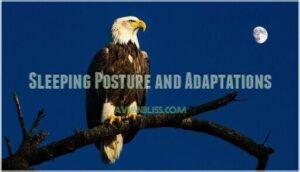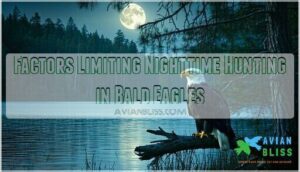This site is supported by our readers. We may earn a commission, at no cost to you, if you purchase through links.
 No, bald eagles don’t hunt at night.
No, bald eagles don’t hunt at night.
You’ll find these magnificent raptors are strictly daytime predators with vision eight times sharper than humans, but they lack the night-vision adaptations of true nocturnal hunters like owls.
Their tubular eyes function as biological telescopes optimized for daylight hunting, missing the enhanced rod cells and reflective tapetum lucidum that enable effective night vision.
While you might occasionally spot a bald eagle scavenging on moonlit nights, their peak hunting occurs during early morning and late afternoon when fish swim near surfaces and waterfowl remain active.
These apex predators spend 10-12 hours nightly roosting to conserve energy for their diurnal hunting prowess, making nighttime hunting both inefficient and evolutionarily unnecessary for their survival strategy.
Table Of Contents
- Key Takeaways
- Do Bald Eagles Hunt at Night?
- Bald Eagle Hunting Behavior: Primarily Daytime Predators
- Bald Eagle Vision: Optimized for Daylight
- Nocturnal Activity in Bald Eagles
- Bald Eagle Sleep Patterns and Roosting Habits
- Factors Limiting Nighttime Hunting in Bald Eagles
- Exceptions: Rare Cases of Nighttime Hunting
- Bald Eagle Daily Routine and Activity Cycle
- Comparison: Bald Eagles Vs. Nocturnal Raptors
- Impact of Human Activity on Bald Eagle Behavior
- Frequently Asked Questions (FAQs)
- Conclusion
Key Takeaways
- You won’t see bald eagles hunting at night – they’re strictly daytime predators with vision eight times sharper than humans, but they lack the night-vision adaptations needed for effective nocturnal hunting.
- They’re missing key nighttime hunting features – unlike owls, bald eagles don’t have enhanced rod cells or reflective tapetum lucidum that enable night vision, making their tubular eyes optimized only for daylight.
- Their peak hunting happens during morning and late afternoon – you’ll find them most active when fish swim near surfaces and waterfowl remain active, not during the 10-12 hours they spend roosting at night.
- Rare nighttime activity involves scavenging, not hunting – while you might occasionally spot them during bright moonlit nights, they’re typically just scavenging rather than actively hunting due to their evolutionary design as diurnal specialists.
Do Bald Eagles Hunt at Night?
When darkness falls, bald eagles don’t hunt at night like owls or other nocturnal predators.
These magnificent raptors are diurnal hunters, meaning they’re active during daylight hours when their exceptional Eagle Night Vision works best.
Bald eagles rule the daylight skies but surrender to darkness when hunting time ends
Their Eagle Behavior revolves around dawn-to-dusk activity cycles, with peak Hunting Strategies occurring during early morning and late afternoon.
Unlike true nocturnal species, bald eagles lack the specialized Nocturnal Adaptations needed for effective nighttime hunting.
Their eyes are optimized for daytime vision, making nocturnal hunting extremely rare.
While you might occasionally spot nocturnal activity during bright moonlit nights, this typically involves scavenging rather than active hunting.
Understanding these Bird Sleep Patterns and eagle hunting techniques reveals why spotting a hunting bald eagle after sunset is virtually impossible—they’re simply not built for it.
Bald eagles typically spend their nighttime hours engaging in restful sleep patterns, which are essential for their overall survival and hunting success.
Bald Eagle Hunting Behavior: Primarily Daytime Predators
You’ll discover that bald eagles are quintessential daytime hunters, with their peak activity occurring during morning and late afternoon hours when thermal currents aid their soaring flight patterns.
These magnificent raptors have evolved specialized adaptations that make them exceptionally efficient diurnal predators, from their acute daylight vision to their opportunistic feeding strategies that capitalize on active fish and waterfowl during daylight hours, utilizing their soaring flight patterns.
Diurnal Nature of Bald Eagles
Bald eagles are diurnal raptors that operate during daylight hours, unlike nocturnal owls.
Their eagle eyesight and visual acuity excel in bright conditions, making daytime hunting their specialty.
These magnificent birds exhibit classic diurnal behavior, with peak activity occurring when the sun’s up.
Eagle behavior studies confirm they’re hardwired for daylight operations, not nocturnal hunting adventures.
Peak Hunting Hours
Most bald eagles concentrate their hunting efforts during ideal daylight windows. Their peak hunting hours occur in early morning and late afternoon when thermal currents aid flight efficiency and prey visibility remains highest.
- Sunrise hunts capitalize on fish surfacing in warming waters
- Midday patrols target weakened or distracted prey near shorelines
- Dusk foraging sessions maximize final feeding opportunities before roosting
Adaptations for Daytime Hunting
These magnificent raptors possess extraordinary visual acuity that surpasses human vision by eight times, allowing precise prey detection from remarkable distances.
Their specialized wing agility enables effortless soaring through thermal currents, while powerful talon strength guarantees successful catches.
Diurnal birds like eagles developed enhanced daytime hunting capabilities through evolutionary adaptations that optimize their hunting strategies for daylight conditions.
Preferred Prey and Hunting Techniques
These remarkable raptors excel at prey selection based on availability.
Fish dominate their diet, comprising up to 90% of meals through specialized fishing techniques.
Their versatile hunting strategies include perch-hunting from vantage points and aerial piracy, stealing catches from ospreys.
- Primary targets: Salmon, trout, waterfowl, and small mammals like rabbits
- Foraging methods: Surface snatching, low gliding flights, and opportunistic scavenging
- Behavioral adaptability: Seasonal shifts from fish to mammals during winter months
Bald Eagle Vision: Optimized for Daylight
Several key features make bald eagles extraordinary daylight hunting specialists with unmatched visual acuity.
Bald eagles possess eight times sharper vision than humans, making them nature’s ultimate daytime predators
You’ll find that eagle vision operates like nature’s most advanced optical system, featuring tubular-shaped eyes that function as biological telescopes.
Their Eagle Eye capabilities stem from specialized optical adaptation – these diurnal predators possess approximately eight times more light-sensitive cells than humans, creating razor-sharp focus during daylight hours.
Unlike nocturnal animals that sacrifice color perception for night vision, bald eagles maintain exceptional color discrimination while maximizing daylight clarity.
Their bird vision system processes visual information at incredible speeds, allowing split-second prey detection from remarkable distances.
This superior visual processing makes them perfectly suited for daylight hunting, where their eyes can distinguish the smallest movements across vast landscapes with surgical precision.
Nocturnal Activity in Bald Eagles
While you might expect bald eagles to be active hunters throughout the night, these impressive raptors have significant limitations when darkness falls.
Their visual systems and hunting behaviors show clear adaptations for daytime activity, making nocturnal hunting extremely rare and challenging for these birds.
Limited Night Vision Capabilities
Unlike their nocturnal counterparts, bald eagles possess limited night vision capabilities that restrict their hunting effectiveness after dark.
Their eye structure lacks key adaptations for low light conditions, creating significant visual limits during nighttime behavior.
- Reduced rod cell density – fewer photoreceptors for detecting dim light
- Absence of tapetum lucidum – no reflective layer to amplify available light
- Smaller pupil diameter – restricts light gathering compared to nocturnal animals
This visual acuity deficit explains why eagles rarely hunt at night, preferring daylight hours when their exceptional distance vision provides maximum hunting advantage.
Bald eagles typically follow a daily sleep pattern influenced by their unique sleep cycle habits.
Rare Instances of Nighttime Activity
You might spot bald eagles breaking their daytime-only rule in extremely rare situations.
These nocturnal activity instances typically involve scavenging rather than active moonlight hunting, as their nighttime vision remains severely limited.
Crepuscular activity occurs more frequently than true nighttime foraging, with eagles occasionally active during twilight hours when prey visibility allows minimal hunting success.
The bald eagle’s behavior is influenced by factors such as eagle habitat protection which affects their population trends and variability.
Factors Influencing Nocturnal Behavior
Several environmental factors can push bald eagles beyond their typical diurnal patterns.
Moonlight effects enhance their limited night vision capabilities, while unusual prey behavior during nocturnal hours may trigger hunting responses.
Environmental factors like artificial lighting or habitat disturbance can disrupt their natural circadian rhythms, occasionally forcing these primarily daytime hunters into nighttime activity when survival demands it.
Comparison With Nocturnal Birds of Prey
Nocturnal birds of prey showcase evolutionary adaptations that diurnal predators like bald eagles lack.
While eagle vision excels in daylight hunting tactics, nocturnal birds possess specialized features for darkness.
- Enhanced night vision – Larger eyes and more light-sensitive cells
- Silent flight capabilities – Specialized feather structures reduce noise
- Acute hearing abilities – Asymmetrical ear placement for precise prey location
The unique characteristics of nocturnal birds of prey enable them to thrive in environments where diurnal birds, such as eagles, are less effective.
Bald Eagle Sleep Patterns and Roosting Habits
You’ll discover that bald eagles follow predictable sleep patterns that help them conserve energy for their demanding daytime hunting activities.
These magnificent raptors establish specific roosting routines that vary seasonally, choosing secure locations where they can rest undisturbed through the night hours.
Typical Sleep Duration
Bald eagles require approximately 10-12 hours of sleep each night to maintain their hunting prowess and overall health.
During breeding season, these dedicated parents alternate rest periods while protecting their nests.
Their circadian rhythms synchronize with daylight patterns, ensuring ideal rest duration for peak daytime performance.
This extended sleep pattern supports their high-energy lifestyle and complex dream cycles.
Preferred Roosting Locations
Bald eagles select strategic roosting locations that maximize safety and hunting success.
These magnificent raptors choose elevated perches near water sources where they can monitor their territory throughout the night.
Their preferred spots include:
- Tree Canopies along river banks offering panoramic views
- Cliff Faces providing natural protection from ground predators
- Forest Edges near established nesting sites for territorial control
Sleeping Posture and Adaptations
During roosting habits, eagles demonstrate remarkable resting postures that optimize energy conservation.
They balance on one leg while tucking the other into their belly feathers for warmth.
Their grip strength remains locked even during deep sleep patterns through specialized tendons.
| Adaptation | Function |
|---|---|
| One-leg stance | Heat conservation |
| Tucked leg position | Energy efficiency |
| Locked grip mechanism | Secure perching |
| Semi-alert sleep state | Predator detection |
This nocturnal activity requires minimal energy expenditure while maintaining perch preferences on sturdy branches.
Eagles at night exhibit these nesting behavior patterns consistently, though they don’t hunt during darkness due to limited night vision capabilities.
The unique sleep patterns of bald eagles involve communal roosting behaviors that support their survival and socialization.
Seasonal Variations in Sleep Patterns
Throughout the year, bald eagles adjust their sleep cycles based on daylight hours and seasonal demands.
During breeding season, pairs alternate nest-watching duties, creating fragmented sleep patterns.
Winter months trigger deeper seasonal adaptations as circadian rhythms shift with shorter days.
Migration periods compress rest time, while molting season allows extended recovery sleep, demonstrating remarkable behavioral flexibility.
Factors Limiting Nighttime Hunting in Bald Eagles
You’ll discover that several key factors prevent bald eagles from hunting effectively at night, including their limited low-light vision and the reduced activity of their preferred prey.
These physiological and ecological constraints have shaped their evolution as specialized daytime hunters, making nighttime hunting both impractical and energy-inefficient.
Visual Limitations in Low Light
Eagle eye structure creates significant visual limitations in low light conditions.
Their retinas contain fewer rod cells than nocturnal birds, reducing light sensitivity for nighttime foraging. Limited pupil dilation restricts light gathering, while absent tapetum lucidum prevents light reflection enhancement.
This diurnal visual acuity specialization makes nocturnal hunting nearly impossible for eagles. The eagles’ eye vision adaptations are highly specialized for daytime hunting.
Prey Availability and Activity at Night
Most fish retreat to deeper waters during nighttime hours, while small mammals and waterfowl remain hidden from nocturnal predators.
You’ll find that nocturnal prey species follow entirely different activity patterns than eagles, creating a timing mismatch.
This limited prey availability makes nighttime foraging inefficient for eagles, who rely on visual hunting rather than starlight navigation or dark adaptation like true nocturnal hunters, utilizing a method that is not based on starlight navigation.
Energy Conservation Needs
Beyond prey availability challenges, bald eagles prioritize Energy Efficiency through strategic rest patterns.
These magnificent raptors employ Conservation Methods that maximize Power Savings during nighttime hours. Their diurnal hunting schedule represents eco friendly resource management, as nocturnal activity would drain essential energy reserves needed for successful daylight hunts.
- Metabolic demands increase substantially during lowlight vision attempts
- Thermoregulation costs rise substantially in cooler nighttime temperatures
- Flight muscle recovery requires extended rest periods for peak performance
- Digestive processes consume considerable energy after large fish meals
- Sustainable Practices favor concentrated daytime hunting over energy-wasteful night efforts
Evolutionary Adaptations to Diurnal Lifestyle
Bald eagles evolved diurnal hunting strategies over millions of years, developing specialized eagle vision with exceptional visual acuity for daylight hunting.
Their circadian rhythms synchronize feeding behaviors with prey activity patterns.
Wing structure and feather camouflage optimize daytime performance while poor lowlight vision limits nocturnal adaptations, reinforcing their hunting strategies around solar cycles.
Exceptions: Rare Cases of Nighttime Hunting
While bald eagles rarely hunt at night, certain environmental pressures can trigger this unusual behavior.
You’ll find that eagles in regions with extreme seasonal light variations or high competition for daytime hunting grounds may occasionally adapt their schedule to secure prey during twilight or early nighttime hours.
Environmental Factors Influencing Night Activity
Several environmental conditions can prompt nocturnal behavior in typically diurnal bald eagles.
While uncommon, these factors occasionally override their daylight hunting preference:
- Moonlight Effects – Bright full moons provide sufficient illumination for limited night vision capabilities
- Cloud Cover – Overcast skies can extend twilight hunting periods during dawn and dusk phases
- Wind Patterns – Calm nights reduce energy expenditure for flight and improve hearing for prey detection
- Temperature Fluctuations – Sudden weather changes force eagles to seek immediate food sources regardless of timing
- Starlight Vision – Clear nights with minimal light pollution enable basic visual prey identification
These environmental adaptations remain exceptions to their diurnal nature.
Geographic Variations in Hunting Behavior
Geographic differences shape when bald eagles hunt substantially.
Arctic populations exploit extended summer daylight, remaining active during bright midnight hours.
Alaskan eagles capitalize on salmon runs regardless of traditional day-night cycles.
Coastal Hunting patterns vary dramatically from inland regions, where Regional Prey availability dictates timing.
Climate Impact and Migration Patterns create diverse nocturnal behaviors across Habitat Diversity, challenging standard diurnal assumptions about eagle hunting behavior.
Understanding these variations requires insight into rare bird behavior patterns that influence their hunting strategies.
Adaptability to Changing Conditions
Changing environmental conditions test bald eagles’ behavioral flexibility through climate shift and habitat change adaptations.
During food scarcity, these diurnal raptors extend hunting hours into twilight periods, demonstrating remarkable environmental resilience despite limited nocturnal vision capabilities.
- Moonlit fishing expeditions during bright lunar phases
- Extended summer hunting in northern latitudes with prolonged daylight
- Migration pattern adjustments requiring occasional night flights
- Opportunistic scavenging during harsh winter conditions when prey becomes scarce
Bald Eagle Daily Routine and Activity Cycle
You’ll discover that bald eagles follow a predictable daily schedule that’s perfectly synchronized with daylight hours.
Their activity cycle begins at dawn with active hunting and continues through structured feeding periods, rest intervals, and energy conservation phases until dusk, which is a part of their daily schedule.
Dawn to Dusk Activities
Early risers know eagles start their day before most wildlife stirs. These diurnal raptors follow predictable Daily Routines driven by Sunlight Behavior patterns.
Morning Hunts begin at first light when fish surface and prey becomes active. Their Daytime Foraging peaks during prime visibility hours, making daylight hunting supremely effective.
| Time Period | Primary Activity |
|---|---|
| Dawn | Territory patrol and Morning Hunts |
| Midday | Soaring and prey surveillance |
| Dusk | Social interactions and roosting preparation |
Hunting and Feeding Times
During peak fishing hours at dawn and dusk, bald eagles demonstrate superior hunting success rates.
These raptors capitalize on prey availability when fish surface and waterfowl are most active.
Their daytime hunting strategy maximizes energy expenditure efficiency through:
- Early morning fishing when salmon and trout feed near surface waters
- Late afternoon opportunistic hunting targeting weakened or spawning fish
- Midday scavenging along shorelines for easy meals
- Seasonal feeding adjustments based on prey migration patterns
Rest Periods and Energy Management
Energy conservation drives bald eagle behavior throughout their daily routine.
These powerful raptors strategically balance activity budgets to maximize foraging success while minimizing energy expenditure.
Their sleep patterns and roosting habits reflect millions of years of evolutionary fine-tuning:
- Extended roosting periods lasting 12-16 hours daily
- Strategic perching between hunting attempts to conserve energy
- Efficient sleep duration optimized for rapid recovery and alertness
Seasonal Variations in Daily Routines
Bald eagles adjust their daily routine throughout the year based on Migration Patterns and seasonal demands.
During Breeding Season, they’re most active with nest-building and territorial defense.
Winter Roosting periods extend longer due to shorter daylight hours.
Food Availability drives hunting intensity during different seasons, and Molting Season reduces flight activity as eagles replace feathers.
These seasonal shifts directly impact eagle behavior, eagle activity patterns, daily routine structure, hunting times, and active periods throughout the annual cycle.
Comparison: Bald Eagles Vs. Nocturnal Raptors
When you compare bald eagles to truly nocturnal raptors like owls, you’ll discover fundamental differences in their hunting strategies and physical adaptations.
These evolutionary divergences explain why bald eagles stick to daylight hunting while their nocturnal cousins dominate the night shift.
Differences in Visual Adaptations
Understanding how vision differs between bald eagles and nocturnal raptors reveals why you’ll find eagles hunting during daylight hours.
Their Eye Morphology features densely packed photoreceptors optimized for sharp daytime vision, while owls possess larger pupils and enhanced Light Sensitivity for darkness.
| Feature | Bald Eagles | Nocturnal Raptors |
|---|---|---|
| Photoreceptor Distribution | High cone density | High rod density |
| Tapetum Lucidum | Absent | Present |
| Visual Acuity | 4-5x human sharpness | Reduced for light gathering |
| Color Perception | Four cone types with UV | Limited color vision |
Eagles lack the reflective tapetum lucidum that gives owls superior night vision, making their vision adaptations fundamentally different.
Hunting Strategies and Prey Selection
When dawn breaks, you’ll notice distinct differences in how bald eagles and nocturnal raptors approach hunting strategies and prey selection.
Bald eagles rely on powerful vision for fish and waterfowl, while night hunters use silent flight for small mammals.
| Feature | Bald Eagles | Nocturnal Raptors |
|---|---|---|
| Primary Prey | Fish, waterfowl, carrion | Small mammals, insects |
| Hunting Techniques | Soaring, swooping dives | Silent stalking flight |
| Hunting Effectiveness | Peak daytime success | Superior nighttime performance |
Ecological Niches and Competition
Most raptors follow nature’s perfect schedule – diurnal eagles hunt when prey’s active, while nocturnal owls capitalize on different opportunities.
This niche partitioning reduces resource competition through temporal separation, though habitat overlap creates occasional interspecific interactions.
Competitive exclusion rarely occurs since bald eagles and night hunters target distinct ecological windows.
| Aspect | Bald Eagles | Nocturnal Raptors |
|---|---|---|
| Primary Hunting Time | Dawn to dusk | Sunset to sunrise |
| Main Prey Species | Fish, waterfowl, mammals | Rodents, small mammals, insects |
| Hunting Strategy | Soaring, perch hunting | Silent flight, ambush |
| Territory Usage | Waterways, open areas | Forests, dense cover |
| Ecological Niches Competition** | Minimal overlap | Temporal separation |
Evolutionary Divergence in Hunting Times
Spanning millions of years, evolutionary divergence shaped distinct hunting windows between diurnal and nocturnal raptors.
Genetic drift and environmental pressures created specialized sensory adaptations, establishing clear niche partitioning that answers "do eagles hunt at night?"
| Evolutionary Factor | Diurnal Advantages | Nocturnal Pressures |
|---|---|---|
| Vision Development | Sharp daytime acuity | Enhanced night sensitivity |
| Prey Specialization | Fish and waterfowl | Small mammals and insects |
| Hunting Strategy | Soaring and swooping | Silent stalking flight |
Impact of Human Activity on Bald Eagle Behavior
You’ve probably noticed changes in wildlife behavior around urban areas, and bald eagles are no exception to human influence on their natural patterns.
While these magnificent raptors remain steadfast daytime hunters, human activities create new challenges and adaptations that affect when, where, and how they hunt for their meals, which can be considered a significant influence.
Light Pollution and Hunting Patterns
Over 40% of bald eagle territories now face artificial lighting exposure, disrupting natural hunting patterns.
Light pollution extends their active hours by 12-17%, though hunting success drops substantially at night.
Urban eagles experience 2-5 times higher nighttime illumination than rural populations.
This behavioral change affects prey behavior and eagle adaptation, creating conservation implications for maintaining their traditional daytime hunting effectiveness.
Addressing this requires effective mitigation strategies.
Habitat Disturbance and Nocturnal Adaptations
Experiencing disruption in their daily rhythm, bald eagles face unprecedented challenges from human encroachment.
Light pollution disrupts their natural circadian cycles, while artificial lighting causes behavioral changes, forcing these majestic birds to adjust their nighttime habits.
- Light Pollution: Artificial lighting disrupts natural darkness patterns essential for proper sleep cycles
- Noise Impact: Traffic and industrial sounds interfere with their acoustic hunting cues
- Habitat Loss: Urban sprawl reduces available roosting and foraging areas
- Human Encroachment: Three-quarters of eagle nests now exist within 230 meters of human structures
Conservation Efforts and Behavioral Changes
Conservation efforts have turned around bald eagle populations through habitat restoration and legal protections.
Population monitoring reveals behavioral changes as eagles adapt to human-modified landscapes.
Supporting eagle protection initiatives can further aid recovery.
These conservation efforts help eagle behavior evolve, with some birds adjusting hunting behavior patterns near urban areas despite human impact and climate change pressures affecting traditional territories.
Future Trends in Bald Eagle Hunting Behavior
Looking ahead, climate change will reshape bald eagles’ hunting behavior in unexpected ways.
These adaptable raptors are already demonstrating remarkable behavioral flexibility as environmental conditions shift.
Future trends suggest significant changes in their approach:
- Urban adaptation strategies will increase as cities expand into traditional territories
- Prey shifts toward new fish species and mammals as water temperatures rise
- Artificial lighting adaptation allowing limited nocturnal hunting in well-lit areas
- Technology impact creating novel feeding opportunities near human infrastructure
Conservation strategies must account for these evolving hunting patterns to guarantee continued population stability.
Frequently Asked Questions (FAQs)
Do eagles hunt at night?
Eagles can’t use their old telegraph systems for nighttime hunting—they’re primarily diurnal raptors.
You’ll find them hunting during daylight hours when their exceptional vision works best.
Their eyes aren’t adapted for nocturnal activity.
Do bald eagles sleep at night?
Yes, bald eagles sleep at night like most diurnal birds.
They roost in tall trees or on cliff ledges, tucking their heads under their wings for warmth and protection during darkness hours.
Do bald eagles hunt daytime?
Bald eagles are primarily diurnal hunters, meaning they’re most active during daylight hours when their exceptional eyesight gives them a significant advantage.
They’ll hunt from dawn to dusk, soaring and spotting prey below, utilizing their exceptional abilities to their fullest extent as hunters.
Do bald eagles hunt together?
Soaring through dawn skies, you’ll witness these majestic raptors displaying complex social hunting behaviors.
Bald eagles don’t typically hunt cooperatively like wolves, but they’ll occasionally hunt in pairs during breeding season, especially when targeting larger prey like salmon or waterfowl.
Can Eagles see at night?
Actually, you’ve got night vision that’d make most creatures jealous!
While not as sharp as their daytime sight, eagles can see reasonably well in low light thanks to specialized eye structures and larger pupils that gather available light effectively.
Do eagles eat at night?
Eagles aren’t night owls in the matter of feeding.
These magnificent raptors stick to daytime dining, relying on their incredible vision to spot prey below.
You’ll find them roosting peacefully after sunset, saving their energy for tomorrow’s hunt.
Where do bald eagles go at night?
While you’d think these majestic raptors would soar through moonlit skies, they’re actually settling down for the night.
Bald eagles roost in tall trees near water sources, using sturdy branches as their nighttime perches for protection and rest.
Do bald eagles see well at night?
Bald eagles don’t see well in darkness.
You’ll find their vision peaks during daylight hours when they’re most active hunters.
Their nocturnal eyesight is limited, explaining why they typically roost at night rather than hunt.
Do eagles fly around at night?
Darkness provides a protective cloak.
Eagles are diurnal birds that are more active in the morning and evening.
At night, they find a comfortable branch to sleep on. Some species of eagles have adapted to hunt at night .
Most eagles primarily roost during nighttime hours, though they’ll occasionally soar for territorial displays or nest maintenance.
What time of the day do eagles hunt?
You’ll observe peak hunting activity during early morning hours from dawn until mid-morning, as these powerful raptors capitalize on thermal updrafts and prey visibility for maximum foraging success.
Conclusion
Remarkably, bald eagles spend 12 hours daily roosting, dedicating half their lives to energy conservation rather than nocturnal hunting.
You’ve learned that these apex predators don’t hunt at night due to their diurnal evolutionary adaptations. Their exceptional daylight vision lacks the specialized features needed for effective nighttime predation.
While you might occasionally observe nighttime scavenging, these magnificent raptors have evolved as daytime specialists, maximizing hunting efficiency during peak prey activity hours when their superior visual capabilities provide the greatest advantage, leveraging their superior visual capabilities and exceptional daylight vision.














